September 29, 2023
Air Date: September 29, 2023
FULL SHOW
SEGMENTS
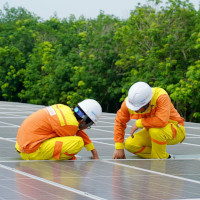
The American Climate Corps
View the page for this story
Ninety years after the creation of the Civilian Conservation Corps, the Biden administration is mobilizing a national workforce to tackle today’s crisis of climate disruption. The American Climate Corps aims to train 20,000 young people in its first year for jobs in clean energy, climate resilience, and land restoration. Trevor Dolan of Evergreen Action joins Host Aynsley O’Neill to discuss. (11:59)

California Leads with Climate Disclosure Bills
View the page for this story
California is poised to enact two laws that would require companies to disclose how climate change affects their business, and how their operations impact the climate. Dave Jones directs the Climate Risk Initiative at Berkeley Law and joins Host Jenni Doering to explain how this transparency can help investors, consumers, and regulators make better decisions related to climate change and business. (11:14)
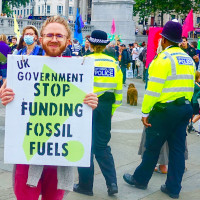
Fossil Fuels Richly Subsidized
View the page for this story
Governments are increasingly touting clean and renewable energy as the way of the future. But if you follow the money, you would find that fossil fuels are receiving massive subsidies, worth around $7 trillion dollars each year, according to a recent report from the International Monetary Fund. Antung Liu is a coauthor of the report and joined Living on Earth Host Steve Curwood to explain how the fossil fuel industry is receiving such generous subsidies every year. (06:58)

Beyond the Headlines
/ Peter DykstraView the page for this story
This week, Living on Earth Contributor Peter Dykstra joins Host Aynsley O’Neill to warn of how climate disasters are hitting the national blood supply. Also, weather disasters hit 90% of US counties in the last decade. And in history, a 40 year anniversary of the release of a nature movie called “Never Cry Wolf” about a scientist’s change of heart about wolves. (03:55)
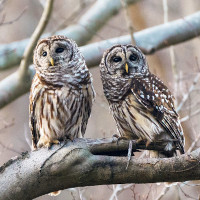
BirdNote®: Strange Sounds
/ Michael SteinView the page for this story
Birds can make an amazing array of sounds, from the call of a male Yellow Rail that sounds like someone tapping two stones together, to Rhinoceros Auklets that have a call resembling a muted chain saw. BirdNote®’s Michael Stein reports. (01:55)
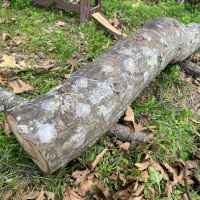
Growing Shiitake Mushrooms in Your Own Backyard
/ Jenni Doering and Aynsley O’NeillView the page for this story
With a few tools and a fresh log, you can grow delicious mushrooms in your backyard that will come back year after year. Hosts Jenni Doering and Aynsley O’Neill team up to inoculate a log with shiitake mushroom spawn. (08:16)
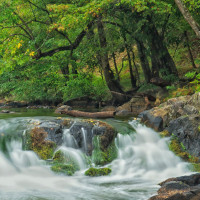
Listening on Earth: Eno River in North Carolina
/ Fern AllingView the page for this story
The Eno River gives life to great blue herons, Eastern box turtles, and yellow trout lilies as it flows through Durham, North Carolina. Living on Earth’s Fern Alling recorded this audio in Eno River State Park. (01:03)
Show Credits and Funders
Show Transcript
230929 Transcript
HOSTS: Jenni Doering, Aynsley O’Neill
GUESTS: Trevor Dolan, Dave Jones, Antung Liu
REPORTERS: Peter Dykstra
[THEME]
DOERING: From PRX – this is Living On Earth.
[THEME]
DOERING: I’m Jenni Doering.
O’NEILL: And I’m Aynsley O’Neill. Uncle Sam wants YOU to fill one of 20,000 jobs in clean energy and climate resilience.
DOLAN: Young folks in America are excited to tackle the climate crisis. You know, they have grown up in a world where they have felt the heat waves, they have had their homes flooded by hurricanes, they have had to flee wildfires. And they want to do something. And the American Climate Corps is providing them with that opportunity.
DOERING: But $7 trillion dollars in yearly subsidies are keeping coal, oil, and gas afloat.
LIU: Explicit fossil fuel subsidies were larger than those on renewable energy by a factor of 19. In other words, we claim as a society that we'd like to subsidize renewable energy, we'd like to foster it and promote it. But in fact, we subsidize and promote fossil fuels much more.
DOERING: Those stories and more, this week on Living on Earth – Stick Around!
[NEWSBREAK MUSIC: Boards Of Canada “Zoetrope” from “In A Beautiful Place Out In The Country” (Warp Records 2000)]
[THEME]
The American Climate Corps
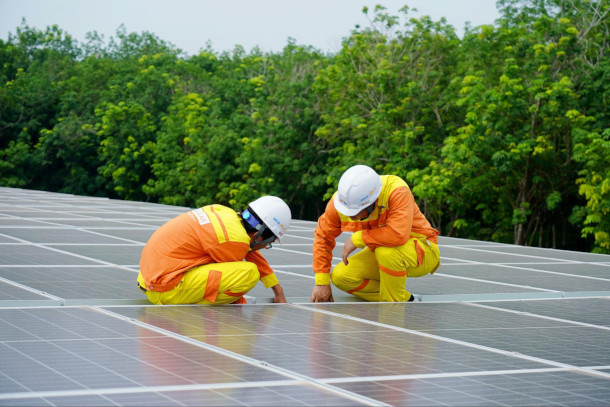
The future clean energy economy will require a technically skilled workforce. (Photo: Trin Trahn, Pexels, CC)
DOERING: From PRX and the Jennifer and Ted Stanley Studios at the University of Massachusetts, Boston this is Living on Earth. I’m Jenni Doering.
O’NEILL: And I’m Aynsley O’Neill. In the throes of the Great Depression, US President Franklin Delano Roosevelt established the Civilian Conservation Corps to put more than 3 million men to work. At state and national parks across the country these mostly young men paved roads, cut trails, and constructed lodges, some of which still stand today. These days you can drive along the Blue Ridge Parkway in North Carolina and Virginia, stay in campgrounds at Acadia National Park in Maine, and hike the Bright Angel Trail in Grand Canyon National Park, all thanks to Civilian Conservation Corps labor. Now, ninety years later, the Biden administration is mobilizing a national workforce to tackle today’s crisis of climate disruption. The American Climate Corps aims to hire twenty thousand young people in its first year for jobs in clean energy, climate resilience, and land restoration. The popular AmeriCorps program will organize the Climate Corps, alongside multiple federal agencies including the Departments of Labor, Energy, Interior, and Agriculture. Trevor Dolan has advocated for a national climate corps with Evergreen Action and he joins me now. Trevor, welcome to Living on Earth!
DOLAN: Thanks, Aynsley, glad to be here.
O'NEILL: What kind of jobs are we talking about here? Paint a picture for me about the world where we have the American Climate Corps. What are people up to? What are they tackling on the ground?
DOLAN: For example, we know that wildfires are burning increasingly out of control as a result of the climate crisis. There are steps that folks can take that the US Forest Service can take, for example, to mitigate wildfires by going in, conducting forestry, removing wildfire fuel from federal lands, and we can have American Climate Corps members who are the ones on the ground with the chainsaws, in the work boots, doing the work of preventing out of control wildfires in the future. I'm from New York City originally. In my parents' neighborhood, there were public EV chargers installed recently, chargers for electric vehicles. Climate Corps members, in partnership with the local electrical workers union, could go out and get trained to install electric vehicle chargers. And then on a New York City block they could be out there and Climate Corps shirts, work gloves on, installing electric vehicle chargers. The same could go for federal funding for retrofitting low income households. Federal dollars are available for folks in low income households to install smart thermostats, beef up their insulation, install solar panels, all these things that can reduce energy costs for people in low income housing, that Climate Corps members can be the ones out there, getting their hands dirty, doing the work that is piecemeal tackling the climate crisis, building resilience.
O'NEILL: Yeah, it sounds like it's a pretty wide swath of career possibilities that they might be going down. And it sounds like they'd be setting them up for future career paths.

American Climate Corps members could be trained to perform on-the-ground wildfire mitigation tasks. (Photo: Tomas del Coro, Flickr, CC BY-SA 2.0)
DOLAN: Absolutely. And I'm really glad you raised that. One of the most exciting parts of this program to me is that the White House is very dedicated to making the American Climate Corps a pathway to a good job in the future. The Biden administration has done a lot of work engaging with labor unions on this, and they are hoping to present Corps members with opportunities for apprenticeships and pre-apprenticeships, basically providing them with the hands on training and credentials that they need to then go out and get jobs in the clean energy economy. Folks installing solar panels or installing smart thermometers in people's homes, you have to learn wiring to do that, right? You have to learn how to handle certain tools. And if the Corps, for example, has partnered with the local IBEW chapter, the International Brotherhood of Electrical Workers, they can build a relationship where they say, you know, three Corps members a year who graduate from our program are going to go on to become IBEW members, apprentices to become journeyman electrical workers. So there are a lot of exciting possibilities here.
O'NEILL: This sounds perfect, especially because the whole target is the youth movement. But what about the people who aren't in the projected age bracket? Is there a way that older folks could get involved?
DOLAN: That is one of the exciting things about the Climate Corps. So we expect that it'll primarily be targeted at young folks who are entering the workforce. That is typically AmeriCorps' target demographic. But we are also hoping to see the Biden administration make jobs available for people who are mid career and looking to transition. And this is especially important because a big part of the Clean Energy Transition is that folks are moving from legacy jobs in the fossil fuel industry, to ideally new good paying union jobs in the clean energy industry. And the American Climate Corps is a really exciting opportunity for them, because it doesn't require going back to school, they don't have a college degree, they don't have to, you know, take out tens of thousands of dollars in student loan debt, they can get paid a good wage to train on the job for a new job as an electrician or a carpenter or any number of roles in the clean energy economy.
O'NEILL: Unfortunately, the climate crisis is so often polarized in our current political climate. To what extent is this program supported across party lines?
DOLAN: Obviously, anything that has climate involved in it is going to be somewhat politically polarized. But what we can say with great confidence is that national service broadly, this idea of the federal government paying folks to do work in their communities, is historically very bipartisan. You know, AmeriCorps funding is not generally a partisan issue. Republicans and Democrats alike really like the idea of the federal government paying people to do good work for their communities. And that's exactly what the Climate Corps is.
O'NEILL: I feel like there's been this narrative that's been presented, a false dichotomy of, oh, you have to choose either the environment or you have to choose good jobs. It feels like this has given us both.

Hands-on jobs like installing EV chargers could prepare participants for future careers. (Photo: Michael Coglan, Flickr, CC BY-SA 2.0)
DOLAN: It absolutely is. And it's really highlighting the generational opportunity that we have with the climate investments coming down through the Inflation Reduction Act. The federal government is investing hundreds of billions of dollars in the clean energy transition, creating millions of jobs over the next decade. There's absolutely no reason those jobs can't be high quality, they can't pay a good wage, provide benefits help families live and thrive.
O'NEILL: This program was really inspired by President Franklin Delano Roosevelt's Civilian Conservation Corps, which was created in the 1930s? What will the ACC, the American Climate Corps be drawing on from that program? And what might it do differently?
DOLAN: You know, it really was inspired by the original Civilian Conservation Corps from the New Deal era. And it really ties in more broadly to the Green New Deal platform, this vision of a return to the ambitious governance, the FDR presidency, where the federal government is a visible presence in communities doing good work. What it will take away from the Civilian Conservation Corps is the original CCC came in at a time of national crisis, you know, we were in the deepest depths of the Great Depression. And FDR created a national jobs program to put people to work, building our national parks, planting trees, paying them enough that they could send money home to their family. The American Climate Corps is coming in at a very similar time in American history. We're staring down years of the climate crisis mounting in intensity. And the American climate Corps is coming in at a moment where we really do need to be marshaling the resources of the federal government and of the American people who want to do this work. And we have seen very much so that young folks in America are excited to tackle the climate crisis. They have grown up in a world where they have felt the heat waves, they have had their homes flooded by hurricanes, they have had to flee wildfires, and they want to do something. And the American Climate Corps providing them with that opportunity. Now as to what we're going to do differently, it's really important to acknowledge whenever we're making comparisons to the original CCC, that it was an almost exclusively white male program, you know, it was incredibly exclusionary towards women and people of color. And President Biden has made it clear that he's committed to doing things differently with the American Climate Corps. As part of the announcement of the ACC, he emphasized that it is going to put a priority on working in disadvantaged communities and hiring people from those places. President Biden has already made a justice 40 commitment to direct 40% of the benefits of climate investments to disadvantaged communities. And the White House emphasized that the justice 40 commitment applies to the American Climate Corps. So the President is really putting in the intentional effort to make sure that this is a much more equitable program that's accessible to everyone, that is investing in every community in America.
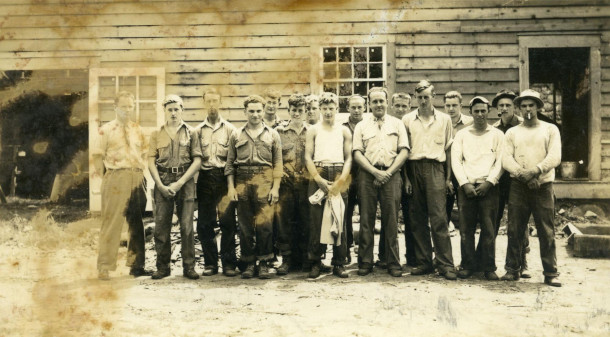
Former President Franklin D Roosevelt’s Depression-era Civilian Conservation Corps did inspire parts of the ACC. However, the Biden administration says the new program will prioritize hiring members from disadvantaged communities. (Photo: Richard, Flickr, CC BY 2.0)
O'NEILL: How might we get the word out about this movement, especially to the disadvantaged communities that are sort of supposed to be at the forefront of this?
DOLAN: I think there are a few answers to that question. The first is, we just need to make sure that we're directing folks to the sign up for the American Climate Corps. Right now, the White House has made a website available, whitehouse.gov/climatecorps, which allows folks to sign up for more news when slots become available. So there are no positions open yet. But they're expecting to start deploying people around summer, fall 2024. So we should certainly start to see things open up sometime soon. For making sure that folks in disadvantaged communities are aware of this, that is a really important question. And I think one that the White House needs to grapple with. But one of the interesting pieces of the American Climate Corps is that there are well over 150, I think, close to 200 different core organizations and communities around the country, organizations that are already taking people, hiring them, putting them to work on community projects, many of them are already doing climate related work. And a lot of them operate in disadvantaged communities. So the American Climate Corp is taking advantage of a network of core organizations, trusted partners in communities that have not had great experiences with federal government and investment and intervention. And really using those relationships to directly invest in these places.
O'NEILL: Now Trevor, I want to get a bit personal and ask why you are yourself so passionate about the ACC? If this had been around at the right time, would you have been interested in a program like this yourself?
DOLAN: Absolutely. You know, I've been working on the Climate Corps for about three years now. I started when I was 26, I think still well within the range of young folks who would want to join the Climate Corps. My work on this partly came from a really personal passion for climate action. I mean, I work for a climate advocacy organization. But in order to get here, I had to go to college, I got a master's degree for the job that I'm in right now. And I realize that those opportunities are not accessible to everyone. And for the most part, one would hope that most of the jobs created in the clean energy economy are not folks working at think tanks. We actually do need electricians and carpenters and folks installing solar panels and mitigating wildfires. And this partly came from a place of my own deep enthusiasm for climate action, and recognizing that other young people around the country are really hungry for opportunities to do something. The Sunrise movement highlights this more directly than anything else. They were the foremost public champions for the Climate Corps during the reconciliation bill negotiations during the era of the Inflation Reduction Act moving through Congress. Sunrise movement mobilized thousands of young people across the country to march and rally for the creation of a Climate Corps. And seeing that level of energy and enthusiasm from young people is one of the reasons I'm so excited about it, because I know that there is an audience out here, and I know that these 20,000 slots are going to be well over subscribed.
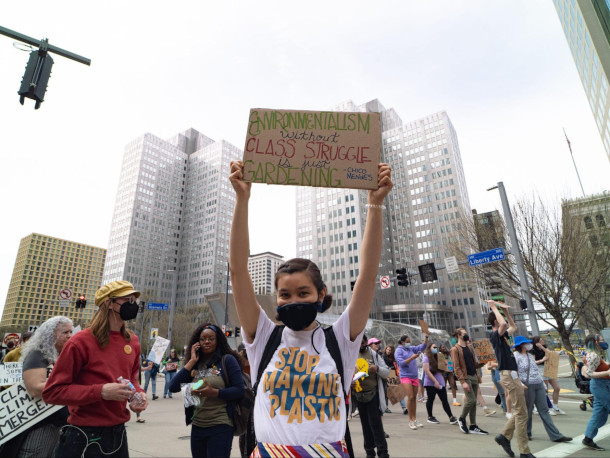
The Sunrise Movement, a youth-led political action organization, has supported the creation of an American Climate Corps. (Photo: Mark Dixon, Flickr, CC BY 2.0)
O'NEILL: Trevor Dolan is a policy lead at Evergreen Action. Trevor, thank you so much for joining us today.
DOLAN: Thanks so much for having me, Aynsley.
O'NEILL: And to find out more about the American Climate Corps, check out the links on the Living on Earth website, loe.org.
Related links:
- Sign up for updates on the American Climate Corps
- About Trevor Dolan
- Listen to a previous segment about the Climate Corps idea
[MUSIC: "Opener" on American Moon Bicycle by Blue Dot Studios, Blue Dot Sessions 2020]
DOERING: If you enjoy the stories you hear on Living on Earth, please consider signing up for our newsletter. You’ll never miss a show, and you’ll have special access to show highlights, notes from our staff, and advanced information about upcoming live events. The Living on Earth newsletter is sent to your inbox weekly. Don’t miss out! Subscribe at the Living on Earth website, loe.org.
[MUSIC: Orchestra Baobab, “El Sow Te Llama” on Specialist in All Styles, by Jose Marquetti, Nonesuch Records, a Warner Music Group Company]
O’NEILL: Coming up, California passes a pair of climate reporting bills in hopes of setting a national standard.
JONES: Part of the objective of these two bills is to get companies to recognize to what extent they’re contributing to the problem of greenhouse gas emissions and also importantly what risks they are facing that might impact their viability, their solvency, their profitability.
O’NEILL: That’s just after the break. Stay tuned!
ANNOUNCER: Support for Living on Earth comes from Sailors for the Sea and Oceana. Helping boaters race clean, sail green and protect the seas they love. More information @sailorsforthesea.org.
[CUTAWAY MUSIC: The Unconservatory Festival Orchestra, “Rumbada” on Danzas Para Does Pianos y Orquesta, by Marilyn Morales, The Unconservatory Festival Orchestra/ufo]
California Leads with Climate Disclosure Bills

California has a population of about 40 million people making the state’s economy one of the largest in the United States, with a $3.7 trillion gross state product (GSP) as of 2022. It is the largest sub-national economy in the world. (Photo: Eric Demarcq, Flickr, CC BY-NC-ND 2.0)
O’NEILL: It’s Living on Earth, I’m Aynsley O’Neill.
DOERING: And I’m Jenni Doering. California has long been a leader on climate and environment issues. And that’s what earned Governor Gavin Newsom the only speaking invitation for a US government leader at the recent UN Climate Ambition Summit hosted in New York.
NEWSOM: We led with the first fully-functioning cap-and-trade program in the United States. We continue to lead as it relates to efforts to completely transition to 100% zero-emission vehicles – the first state in America to establish a firm goal. And we also have established the most comprehensive plan to implement – we call it ‘the great implementation’ – our ambitious goals and advance our low-carbon, green-growth future.
DOERING: Now the Golden State is poised to enact two laws that would require companies to disclose how climate change affects their business, and how their operations impact the climate. The bills are on Governor Newsom’s desk as of this broadcast and joining us from Sacramento to discuss is Dave Jones, a former California Insurance Commissioner and the Director of the Climate Risk Initiative at Berkeley Law. Dave, welcome to Living on Earth!
JONES: Great to be with you.
DOERING: So let's start with the climate risk disclosure law, California Senate Bill 261, which I understand you were involved in drafting, what does this bill require companies to do?
JONES: This bill, for the first time requires companies and financial institutions to disclose their financially related climate driven risks. So this is a requirement, once it's signed by the governor, for the first time and sets a national standard. Companies and financial institutions will have to use the Task Force on Climate Related Disclosure Framework, which was adopted by the GE 20 some years ago. And basically, in addition to reporting emissions, they have to identify and disclose climate driven risks that they face, both in their operations and in their financial operations as well.
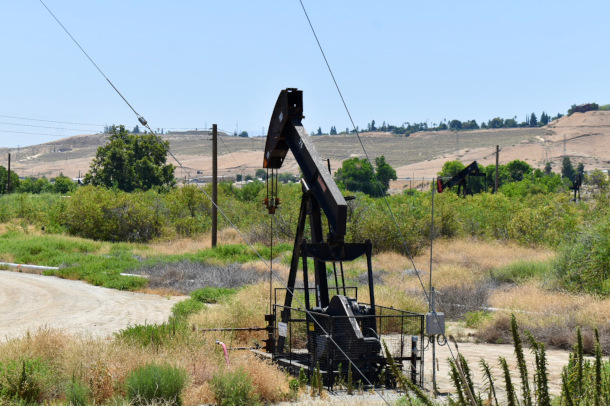
A pumpjack in the oil field in Bakersfield, California. The state of California is suing the oil companies BP, ExxonMobil, Chevron, Shell and ConocoPhillips and their trade group, the American Petroleum Institute, over what the state says is a long-standing pattern of deceiving the public over the risks associated with fossil fuels. (Photo: Babette Plana, Flickr, CC BY-NC 2.0)
DOERING: And what are those risks look like for companies and financial institutions?
JONES: So it differs by company. If you are, for example, a bank that's making loans into areas impacted by climate change, maybe you're lending to homeowners in areas that are facing wildfire risk, or flooding, or sea level rise, you would need to disclose the fact that you're lending to homeowners that are facing those risks. And that those consequences of climate change, which include more wildfires, more floods, more sea level rise, could impact the homeowners that you're lending to and potentially have consequences for their ability to repay their loans, and thus have consequences for your financial balance sheet. If you're a utility that's operating on a coast, maybe a coast that is impacted by more frequent and severe storms, you would need to disclose the fact that those consequences of climate change could impact your operations as a utility. So it varies based on the nature of your business. but the objective is the same. It's to get companies to think about and report and make public the risks that they face from the impacts of climate change.
DOERING: So why is it important for companies to be disclosing the financial risks of climate change?
JONES: Investors and shareholders and owners of companies as well as consumers of goods, and policymakers and regulators need to understand the risks that are facing financial institutions and companies from climate change, particularly with regard to the financial sector. The Federal Reserve and the Department of Treasury have already identified climate change as a potential systemic risk to our financial system. And it's important that companies and financial institutions evaluate what that risk is, and then disclose it. A part of the TCFD (Task Force on Climate Related Finance Disclosure) framework that companies will have to use to disclose their financial risks under Senate Bill 261 is to identify what governance mechanisms are putting in place to address climate change, what their strategy is to address the risks from climate change, what they're doing vis-à-vis risk management, and then they're supposed to set targets to try to address the risks as well. So institutional investors like pension funds, for example, the pension funds for firefighters, or police officers, or teachers, they are investing literally trillions of dollars in companies across the economy. It's critically important that institutional investors like pension funds, and others understand what are the climate change driven risks that the companies that they're investing in face? And what are those companies doing about that, so that they know that those investments will be protected, and will provide a reasonable return.
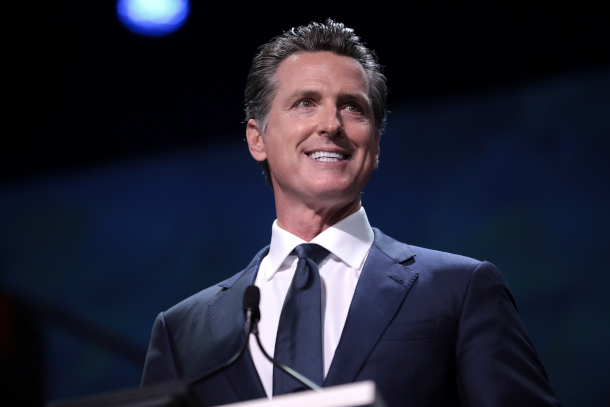
During the Climate Ambition Summit, Governor Gavin Newsom said that he would sign bills SB 253 and SB 261, the greenhouse gas emissions bill and the financial climate risk disclosure bill. These bills are intended to require major corporations to be more transparent about greenhouse gas emissions and the financial risks stemming from global warming. (Photo: Gage Skidmore, Flickr CC BY-SA 2.0)
DOERING: So that was the climate risk disclosure law. And this other bill, Senate Bill 253 requires companies to disclose their supply chain emissions. Can you walk us through that law, please?
JONES: So Senate Bill 253 By Senator Scott Wiener establishes for the first time a requirement that companies that make over a billion dollars a year in revenue, disclose what's called their scope one, scope two, and scope three greenhouse gas emissions. Scope one emissions are emissions from the direct operations of the company, let's say it's a company that manufactures cars and so the emissions associated with the manufacturing the cars have to be reported. Scope two basically covers the inputs to manufacturing associated with energy. So the electricity costs, heating costs, that sort of thing. They would report the emissions associated with the utilization of energy. Scope three are indirect emissions that are associated with supply chain both upstream and downstream for the company. So if you think about the inputs, associated with manufacturing a car, it might be steel, might be rubber, they would need to report the emissions associated with the manufacture of those things, as well as going downstream to the actual end users of the cars and they'd have to calculate and report the emissions associated with the actual utilization of the cars that they manufacture. So these scopes scope one, scope two, and scope three are well defined, they've been in existence for some time. They've been used extensively by European and Asian regulators. And also some US companies have voluntarily disclosed their scope one, scope two, scope three emissions, this is the first time that a law has been enacted to require the disclosure of these emissions.
DOERING: Why are these kinds of disclosures important?
JONES: It's critically important to understand the extent to which companies and financial institutions are contributing to climate change through their emissions. There's no question that climate change is real, we're seeing global temperatures rise, it's causing more severe and frequent weather related disasters, that's killing more people, injuring more people, destroying more communities. You saw this recently, sadly, in Maui floods, in Vermont, the list goes on and on and on of these climate driven events. And sadly, there's so much temperature rise already baked into the system due to greenhouse gas emissions, that we're going to see this continued increase in frequency and severity of these events. So in order to combat that, we need to understand to what extent are corporations and financial institutions contributing to the greenhouse gas emissions that are literally posing an existential threat to life as we know it on the planet. Before we can actually manage this problem well, we need to measure it so that policymakers and regulators and consumers and investors understand what contribution that company or financial institution is making to this problem. And then they can determine what sort of response or measures they want to take to respond to that.

Senator Scott Wiener sponsored Senate Bill 253, the Climate Corporate Accountability Act. (Photo: Scott Wiener, Wikimedia Commons, CC BY-SA 3.0)
DOERING: So California is the world's fifth largest economy. So how might these bills impact other states?
JONES: Because California is the fifth and maybe becoming the fourth largest economy in the world, major corporations throughout the United States and major financial institutions are in California's market. And that allows California to reach corporations regardless of where they're headquartered, and financial institutions regardless, where they're headquartered with these two requirements, in effect setting a national standard. It's critically important to have a national standard because so far, United States federal regulators have not required greenhouse gas emissions reporting, or for that matter, reporting of financial risks associated with climate change in a comprehensive and systemic way. And so US Federal Financial regulators are behind. So California has decided not to wait, but rather to act, and in so doing establish a national standard.
DOERING: Now I understand the US Securities and Exchange Commission is preparing to release its own finalized rules on climate disclosure. From what we know so far how do the California bills compare and interact with those rules?
JONES: The chair of the SEC, Gary Gensler announced the other day, in the wake of the governor of California's announcement that he was going to sign the bills that these bills SB 253, and SB 261, the greenhouse gas emissions bill and the financial climate risk disclosure bill are in alignment with what the SEC is considering and actually support what the SEC is considering. The SEC has to actually do a cost benefit analysis as a part of issuing a new rule of disclosure for stock companies and the fact that California is enacting a law that already requires some 10,000 companies to do financial risk disclosure, actually will reduce the cost impact of the SEC rule and make it a little more easier for the SEC to put forward and move forward with that rule. So what California is doing is definitely in alignment with but it's also designed to try to encourage the US financial federal regulators to move ahead and to catch up with their European and Asian colleagues. So it's very exciting in the sense that it's taken some time to get to this place, but to see these two bills passed, and on the governor's desk and the Governor announced that he's going to sign them that's a really big deal.
DOERING: Dave Jones directs the climate risk initiative at Berkeley Law thank you so much Dave.
JONES: My pleasure.
Related links:
- Cal Matters | “Newsom to Sign Corporate Climate Accountability Bills”
- CA Gov | “Governor Newsom Doubles Down on Building California’s Future to Achieve World-Leading Climate Goals”
- Learn more about Dave Jones
- CA Gov | “Governor Newsom Calls Out Oil Industry at UN: ‘This is a Fossil Fuel Crisis’”
- Learn more on the Task Force of Climate Related Finance Disclosures
- Learn more about SB-253
- Learn more about SB-261
[MUSIC: Julian Lage & Chris Eldridge, “Rygar” on Mount Royal, Free Dirt Records
Fossil Fuels Richly Subsidized
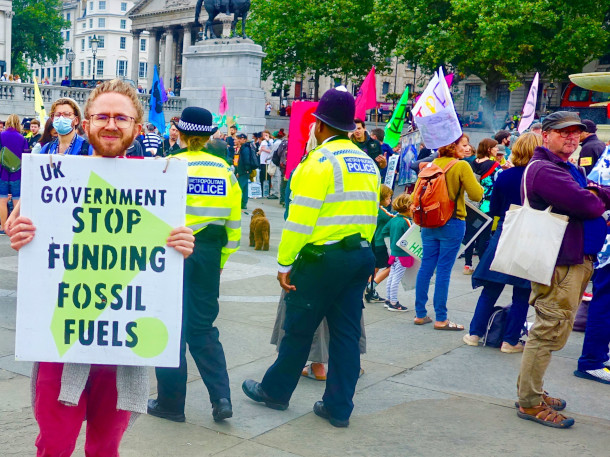
A protester in the UK rallies against United Kingdom funding of fossil fuel projects (Photo: Gerry Popplestone, Flickr, CC BY-NC-ND 2.0)
O’NEILL: Governments and the private sector are increasingly touting clean and renewable energy as the way of the future. But if you follow the money, you might get a very different impression. That’s because fossil fuels are receiving subsidies worth around $7 trillion dollars each year, according to a recent report from the International Monetary Fund or IMF. Antung Liu is a Technical Assistance Advisor with the International Monetary Fund and a coauthor of the report. He joined Living on Earth Host Steve Curwood.
CURWOOD: Your paper talks about $7 trillion in subsidies; about a trillion and a half of that are direct, or explicit, subsidies. How do governments directly give money to the fossil fuel industry?
LIU: These aren't typically handouts directly to the fossil fuel industry. Rather, they're handouts that they intend for people. A lot of governments are extremely sensitive to the prices of energy, because it's very popular to have low energy prices. For example, in the United States, one of the most salient or visible prices in the economy is the price of gasoline. Every corner, you drive around, and you see these prices posted. And so people are really sensitive about these prices. So a lot of governments subsidize the cost of energy in order to stay popular, in order to keep the prices of energy commodities low. So that 20%, that 1.4 trillion, is that: keeping prices artificially low, below what it should cost to make these energy products.
CURWOOD: Now, implicit subsidies are prices that don't consider the social costs, such as air pollution, or climate disruption, or congestion, or development issues. And I guess 80% of the subsidies that you looked at are implicit. How can you capture the value, though, of those implicit subsidies? How can you put a price, say, on air pollution or climate change or congestion?
LIU: So it's a separate line of work to think about how big the external cost of energy products is. So, the cost to society not reflected by the gas seller or the gas consumer, the person buying the gas or the gas station. And so for example, the external cost of gasoline is congestion. It's been found to be the number one cost, which is that when I drive my car, I don't consider the effects of driving my car on other people, and especially in cities like New York, or Los Angeles, the congestion is very high. And so when I drive my car, it causes other people to not get to their places as quickly. For coal fired power, for example, the air pollution is very high. So it sheds particulate matter, unless you put a scrubber on it, there's sulfur dioxide, that has a negative impact on our health. All these costs should be reflected in the price to the consumer. And the best way to do that is a price on carbon. So there's nearly universal agreement among environmental economists and the economics profession in general, that we need to think about a carbon tax or emissions trading system, an ETS, in order to help the market cost of fossil fuel reflect its social cost.
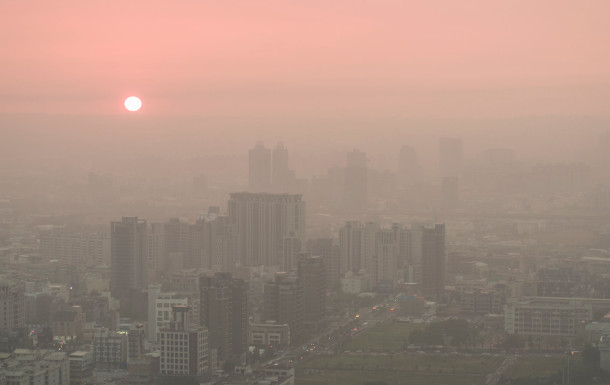
According to the IMF, fossil fuels receive implicit subsidies when they are not priced to account for external costs including those resulting from air pollution. (Photo: 君勇 林,Flickr, CC BY-NC 2.0)
CURWOOD: Hmm. Boy, getting stuck in traffic in Boston, the way many of us, where our studio's located, that price would be very high! It takes a long time to get across town.
LIU: Yeah, absolutely. You think about all the millions of people stuck in traffic, all the time that lost, what they could be doing otherwise, that's the real pain of congestion.
CURWOOD: Now, how do fossil fuel subsidies compare to renewable and carbon free energy subsidies?
LIU: This is a great question and one that we didn't directly examine in our report. I found statistics from the International Energy Agency, which found that in 2022, global spending on clean energy, not subsidies, was only $1.6 trillion. This is dwarfed by the $7 trillion figure that we find in our report. To examine the question of subsidies and fossil fuels versus those subsidies on renewable energy, I found a report in 2020 from the International Renewable Energy Agency, which said that explicit fossil fuel subsidies were larger than those on renewable energy by a factor of 19. In other words, we claim as a society that we'd like to subsidize renewable energy, we'd like to foster it and promote it. But in fact, we subsidize and promote fossil fuels much more.
CURWOOD: Sounds like for almost every $20 bill that's spent on government subsidies for fossil fuels, less than $1 goes to the renewable energy business.
LIU: That's an apt way of putting it, yeah.
CURWOOD: So what is the economic case for eliminating fossil fuel subsidies?
LIU: So government budgets are limited, you know, we're living in a time where nearly every country operates at a deficit. The United States, you know, the CBO, Congressional Budgetary Office, recently said that spending exceeds our revenues by like 5% of GDP each year. And so there's limited fiscal resources to go around. And one of the points we make is that when there's a time of limited fiscal resources, you shouldn't spend money on things that are very wasteful. You know, you could be spending money on health care, you could be investing in education or infrastructure. Instead, you're artificially lowering fossil fuel prices. And that has a negative impact to health, to congestion, to global warming. You got to understand that the social cost is actually mostly local, the benefits received from reducing fossil fuel subsidies aren't realized far away. So if China reduces its emissions, the United States perceives a part of the benefit but most of it stays in China. For example, congestion and air pollution are both local environmental problems. And so it's in most countries' self-interest to eliminate subsidies.
CURWOOD: All right, time for a reality check, Professor Liu. The fossil fuel industry is extremely powerful and influential, to put it mildly, and deeply involved in political systems and governments around the world. So how can these subsidies get phased out?
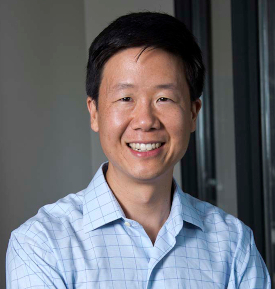
Antung Liu is a Technical Assistance Advisor at the International Monetary Fund. (Photo: Courtesy of Antung Liu)
LIU: We think that the benefits to society are very large. And you're right, that there are costs on some parties. So as a society, we need to agree collectively that we want to move into a better place. We think that a price on carbon should be part of a comprehensive reform. Raising people's fuel prices is really unpopular, right? Like if you raise my electricity cost here, I'd be grumpy about it. I think a lot of people might feel that way, if that's all that happened. But then when you consider the broader implications of a policy package that we think should include it all, which is, you know, spending the money that you were previously using on explicit fossil fuel subsidies and putting it somewhere else, to invest in health care. So when Iran eliminated its subsidies on gasoline, it sent households a check, every household got a check that helped cushion the blow. And for the poorest households who weren't spending very much money on gasoline, because maybe they didn't have a car or they didn't use a car very much. They were actually much better off than they would have been. I think that'd be popular and you know, people would begin to see hey, overall, we're better off when we have raised the price of energy.
O’NEILL: Antung Liu is a Technical Assistance Advisor with the International Monetary Fund. He spoke with Living on Earth Host Steve Curwood.
Related links:
- Read the IMF report
- About Antung Liu
[MUSIC: "Charcoal Lines" on Sketchbook by Blue Dot Studios, Blue Dot Sessions 2020]
DOERING: Just ahead – we’ll try growing tasty shiitake mushrooms right at home. Keep listening to Living on Earth.
[CUTAWAY MUSIC: KAL, “Mozzarella” on KAL, by Dushan Ristic and Dragan Ristic, Asphalt Tango Records]
Beyond the Headlines

There is a nation-wide blood shortage due in part to natural disasters preventing Americans from donating blood, according to the American Red Cross. (Photo: ec-jpr, Flickr, CC BY ND-NC 2.0)
O’NEILL: And I’m Aynsley O’Neill. It's time now for a look beyond the headlines with Peter Dykstra. He's our Living on Earth contributor from Atlanta, Georgia. Hey there, Peter, what do you have for us this week?
DYKSTRA: Hi, Aynsley. The American Red Cross says that the blood supply available in the United States is at critically low levels. And one of the reasons they say why it's at critically low levels is climate change.
O'NEILL: That doesn't sound so good, Peter, what's going on there?
DYKSTRA: Well, it's not as if we don't have enough lovely things to think about with climate change. But what the Red Cross and other organizations have said, is that patients don't stop getting sick when there's a natural disaster. But they do stop giving blood. And that's created a crisis that hits hard every time the Red Cross has already been called into action, to help deal with the wildfire, or the hurricane or flood, or any of the many, many things that they do to help Americans out of disaster. The blood supply is one of the most important and it's getting smacked by climate change as so many other things are.
O'NEILL: Sounds like one disaster turns into another disaster compounding into another disaster, Peter, not a very good cycle.
DYKSTRA: Not at all.
O'NEILL: All right. Well, Peter, what else do you have for this week?
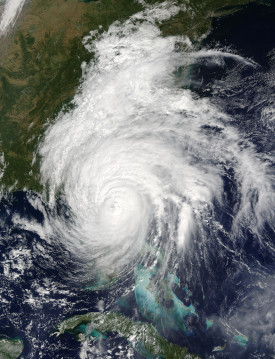
Hurricane Matthew (2016) looms large over the east coast of the United States, one of the hardest-hit regions for natural disasters between 2011 and 2021. (Photo: NASA Goddard Space Flight Center, Flickr, CC BY 2.0)
DYKSTRA: Another item about the climate crisis. 90% of US counties had a weather disaster between the years 2011 and 2021. That according to a recent report, and website called Atlas of Disaster. You can go online and see the counties that have had disasters. Some counties, as many as 12. And it's really an eye-catching way to show that nearly all of us have been impacted by climate change in the last decade or so.
O'NEILL: 90% is hard to fathom. I mean, who even got spared over that last decade?
DYKSTRA: A lot of sparsely populated western counties in places like Wyoming and Nevada had no disasters to speak of in that decade ending in 2021.
O'NEILL: Now, Peter, what do you have for us from the history books this week?
DYKSTRA: Something that happened 40 years ago. October 7, 1983. There was a wonderful, although sparsely seen, nature movie called Never Cry Wolf. It was released and based on the memoirs of the nature writer Farley Mowat, a great Canadian writer, The film tells the story of a Canadian government scientist sent to study the menace of wolves, only to find out that they didn't need to be regarded as a menace. He was absolutely enchanted with wolves. That main character is played by Charles Martin Smith.

October 7, 2023 marks the 40th anniversary of the nature-drama film Never Cry Wolf, starring Charles Martin Smith. (Photo: Internet Movie Poster Awards, Wikimedia Commons, Fair Use)
O'NEILL: Charles Martin Smith. Why does that name sound familiar, Peter? What else would I know him from?
DYKSTRA: He was a supporting player in a couple of hit movies in the 70s and in the 80s. He was one of the high school kids coming of age in American Graffiti. And in the 80s, he played a government accountant who helps unravel the finance behind Al Capone and gets him locked up for income tax evasion.
O'NEILL: So should I put those on my list as a triple feature for homework, Peter? American Graffiti, The Untouchables, Never Cry Wolf?
DYKSTRA: Start with Never Cry Wolf.
O’NEILL: Okay, and add the other two later. All right. Well, thank you, Peter. Peter Dykstra is a contributor to Living on Earth, and we will talk to you again real soon.
DYKSTRA: All right, Aynsley. Thanks a lot. Talk to you soon.
O'NEILL: And there's more on the stories on the Living on Earth website. That's LoE.org.
Related links:
- E&E News by Politico | “How Global Warming is Worsening a National Blood Shortage”
- Yale Climate Connections | “90% of U.S Counties had a Weather Disaster Between 2011 and 2021”
- Rebuild by Design | “Atlas of Disaster”
- IMDb | “Never Cry Wolf (1983)”
[MUSIC: BirdNote Theme]
BirdNote®: Strange Sounds
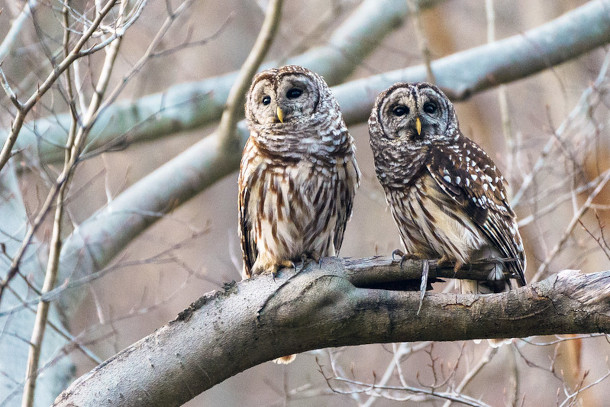
A pair of barred owls perch on a tree branch. (Photo: Mike Maquire, CC)
DOERING: Scientists estimate that there are around ten thousand or so different species of birds today, each with its own strange and wonderful calls. BirdNote®’s Michael Stein has more.
BirdNote®
Strange Sounds
[Call of Yellow Rail] Some bird calls can sound like somethin’ else altogether! For example, one could easily mistake the call of a male Yellow Rail, [Call of Yellow Rail] for someone tapping two small stones together.
What about this sound? [Turkey Vultures hissing] They’re Turkey Vultures hissing at one another over a carcass!
What about this plaintive whistle? [Call of a male Black Scoter] That’s the call of a male seaduck, a Black Scoter.
And what could possibly be going on here? [Caterwauling of Barred Owls] That’s a duet between a male and female Barred Owl!
And this one? [Call of Rhinoceros Auklet] Do we have a miniature cow with a chain saw? No, that’s the call of the Rhinoceros Auklet, a seabird, deep in its nest burrow.
Finally, what bird call resembles the howl of a wolf? [Wail call of the Common Loon] That’s the wail call of the Common Loon.
What an amazing array of sounds birds have to offer.
Ours are brought to you by arrangement with the Cornell Lab of Ornithology. Hear them all again at birdnote.org. [Wail call of the Common Loon]
###
Bird vocalizations provided by The Macaulay Library at the Cornell Lab of Ornithology, Ithaca, New York. Call of the Yellow Rail ML 125394 recorded by Thomas Sander; Turkey Vultures by Greg Clark; Black Scoter ML 130900 by Gerrit Vyn; Barred Owls ML 63003 David Herr; Rhinoceros Auklet ML 110904 Thomas Sander; Common Loon ML 107963 S.R. Pantle.
BirdNote's theme music was composed and played by Nancy Rumbel and produced by John Kessler.
Producer: John Kessler
Executive Producer: Chris Peterson
© 2015 Tune In to Nature.org May 2015 / October 2023
Narrator: Michael Stein
ID# sound-09-2015-5-30 sound-09
https://www.birdnote.org/listen/shows/strange-sounds
DOERING: For pictures, flap on over to the Living on Earth website, LoE.org.
Related link:
Listen to this story on the BirdNote® website
[MUSIC: Ambient Music]
Growing Shiitake Mushrooms in Your Own Backyard
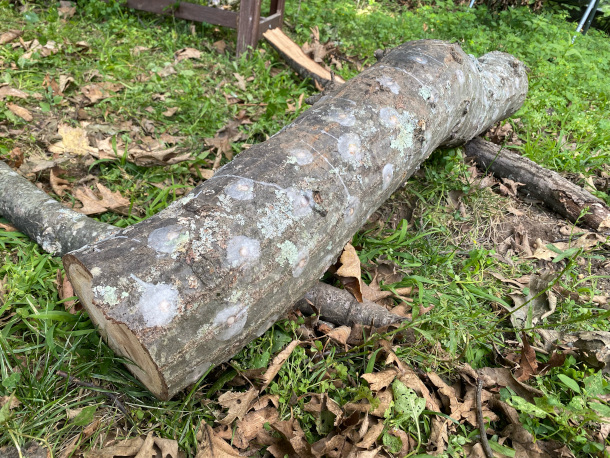
The fully inoculated log, covered in protective wax. (Photo: Aynsley O’Neill)
DOERING: So, Aynsley I could use your help with a backyard experiment.
O’NEILL: Oh? Tell me more.
DOERING: I’m trying to grow shiitake mushrooms. I’ve got a kit and everything.
O’NEILL: Oooh, delicious! Those are so good in soups, pastas and even vegan “bacon”.
DOERING: Yeah! So the kit comes with wood plugs called spawn that are covered in this white fuzzy mycelium. That’s the fungal network that mushrooms sprout from. There’s also some wax to seal the log once the wood plugs are in. And then you just need a drill to make the holes, a hammer and a fresh log. In fact, the wood is what started this whole little experiment, when a big branch fell from the red oak that towers over my backyard. So, first step is drilling some holes in the log. You ready for this?
O’NEILL: Yeah, let’s get to it!
[DRILLING SFX]
O'NEILL: Thank you for using your eye protection, Jenni.
DOERING: Yes. This log is really hard. I swear I know how to use a drill. Oh, there we go.
O'NEILL: Yeah.
[DRILLING SFX]
DOERING: Okay, one row down.
O'NEILL: So your plan is to drill all the holes and then insert the dowels.
DOERING: Yeah. So there's these little plugs, wood plugs, and check out that fuzzy white stuff.
O'NEILL: Yeah.
DOERING: That's the spawn.
O'NEILL: Yeah, at first, I thought it might be bad. Like it might be moldy itself, but I guess that's the point.
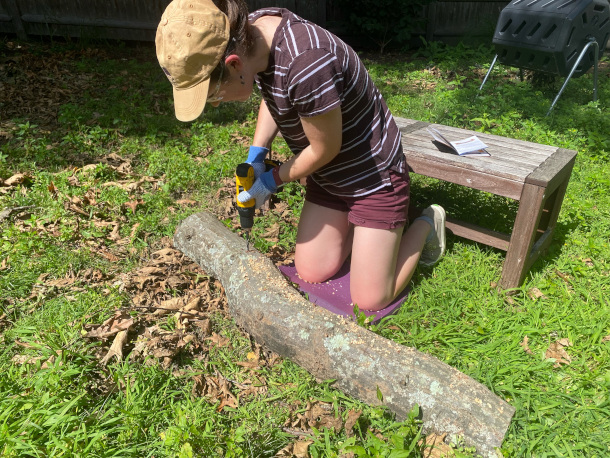
Producer Jenni Doering drills a series of holes into the log. (Photo: Aynsley O’Neill)
DOERING: Yeah, those are the little spawn. I don't think they're called spores at this point. But it's living mushroom stuff.
O'NEILL: Alright. We didn't get this on tape. But I'll say for the record that I also drilled some holes.
DOERING: Yes. I think it should be on record. Aynsley did half of the drilling of the holes as well. All right, let's give it a whack. Yeah.
[HAMMER SFX]
O'NEILL: Perfect.
DOERING: Awesome. Satisfying.
O'NEILL: Now, you said that this is from a red oak? Are there certain kinds of trees that go better with certain kinds of mushrooms?
DOERING: Yes, actually, I guess oaks and shiitakes go well together. There's a whole list here of which species of tree go best with which species of mushrooms. So I love oyster mushrooms.
O'NEILL: Ooh.
DOERING: And those are really good with aspen and cottonwood and willow. If you want hen of the woods, which is a more difficult mushroom to grow apparently, oak is actually the only one that hen of the woods really likes.
O'NEILL: Wow. And there's something cool about sitting in the shade of the oak tree that we're now using.
[HAMMER SFX]
DOERING: Meta, yeah.
O'NEILL: Yeah.
DOERING: Yep. Yeah, this is all very local, except for the spawn. It was shipped to me. I don't know how old that oak is. But it's at least... is that, like, three feet thick?
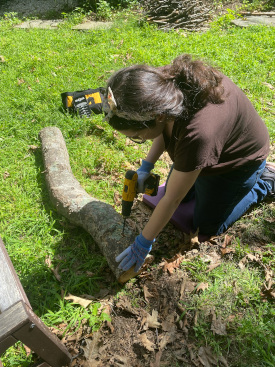
Producer Aynsley O’Neill drills a hole into the log. (Photo: Jenni Doering)
O'NEILL: Looks like it.
DOERING: At the trunk?
O'NEILL: It's pretty glorious.
DOERING: Yeah, it's a big old oak. A lot of the wood went to our friends for firewood this winter.
O'NEILL: Oh, nice.
DOERING: It was a big branch that fell. And then, figured, let's see if we can make some mushrooms out of the rest. Okay.
O'NEILL: Nice.
DOERING: So far, so good.
O'NEILL: Yeah.
DOERING: Do you want to do some?
O'NEILL: I'll do some.
DOERING: All right, let's switch.
[RUSTLING SFX]
O'NEILL: Alrighty. Okay. Eugh!
DOERING: I know. Gross. Do you have a favorite mushroom?
O'NEILL: I don't know. I do think that oyster mushrooms are very tasty and very adaptable. I think we once did a segment were you brought in oysters from a local vegan restaurant for like a vegan Thanksgiving dish?
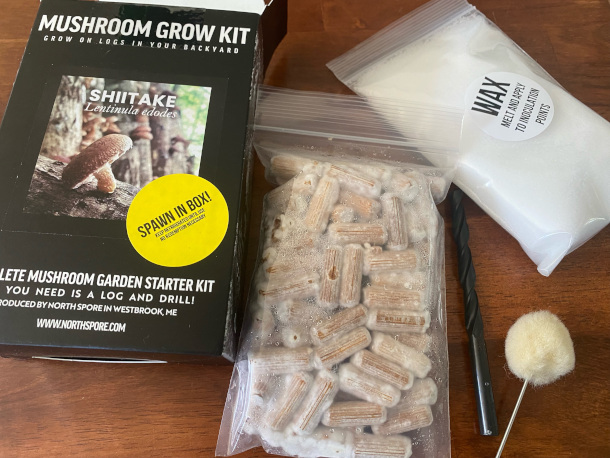
A mushroom grow kit typically includes mushroom spawn, a drill bit, wax, and a tool to dab wax on the log. (Photo: Aynsley O’Neill)
DOERING: Yes.
O'NEILL: Those were so good!
DOERING: Yeah, the fried oyster mushrooms I believe.
O'NEILL: Yeah.
DOERING: From, from Red Lentil, down the street from here
O'NEILL: Wait, truffles are mushrooms.
DOERING: Yes, they are.
O'NEILL: Truffles are super good. I had truffle potatoes the other day. Those are good.
DOERING: Fancy shmancy!
O'NEILL: Yeah.
DOERING: Yeah, and then I always love getting wood ear mushrooms in my ramen.
O'NEILL: Oh, those are very good.
[HAMMER SFX]
DOERING: Those guys? Delicious. There's a lot of different kinds.
O'NEILL: That's one of the things that's so cool about mushrooms, right? Is that they, they do everything.
DOERING: Yeah. I really like hated mushrooms as a kid. Like, especially cooked mushrooms because they were slimy.
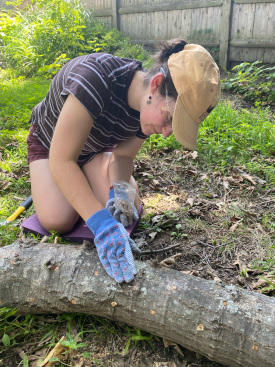
Producer Jenni Doering hammers a spore-covered plug into one of the drilled holes. (Photo: Aynsley O’Neill)
O'NEILL: Oh, yeah.
DOERING: And then, you know, it's weird how when you're a kid, sometimes that switch just flips. And all of a sudden, your least favorite food becomes your favorite food.
O'NEILL: I feel like there's a lot of things where if you just give it enough chances...
DOERING: Yeah.
O'NEILL: Oh my God, I can't aim this hammer for the life of me.
DOERING: It's hard, it's right by a knot.
[HAMMER SFX]
O'NEILL: Yeah, that one went in much easier!
DOERING: Last one! All right.
O'NEILL: Yeah! Nice.
DOERING: Now, for the wax. We're not done yet.
O'NEILL: Oh! I forgot about the wax, I thought now to put it in its home where it can rest forever. No. Let's go get the melted wax!
[RUSTLING SFX]
DOERING: Yeah. All right, so I'll just start. Whoa, it's like turning white as it-
O'NEILL: -as it hardens?
DOERING: Yeah, as it gets on the log.
O'NEILL: It is really cool to see it sort of seal up immediately.
DOERING: I know, right?
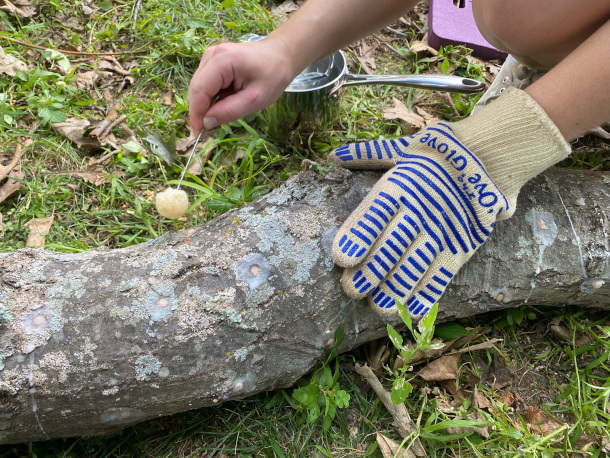
The last step in inoculating a log with mushroom spawn is sealing it with melted wax. (Photo: Aynsley O’Neill)
O'NEILL: As the wax cools so fast. That's so cool.
DOERING: Yeah, it looks like icing now. Maybe I am hungry.
O'NEILL: And so we're sealing it with the wax but why is it important to seal it?
DOERING: So I guess we want the mushrooms that we want. That we like. Shiitake mushrooms. We want those to colonize the log instead of some other random fungi. You know, this isn't a sterile environment so like it's possible that there's other fungi that got in there just while we were drilling and such but I think this is like giving the, the shiitakes a head start.
O'NEILL: Yeah, they're gonna out compete for sure.
DOERING: Yeah, like you saw all that white fungus stuff.
O'NEILL: Yeah.
DOERING: And then they say to set it up in a spot that's not gonna get too dry. So this back corner is nice and shady.
O'NEILL: Yeah.
DOERING: By the compost is kind of a good spot too, maybe, because it's by another rot-
O’NEILL: Decay.
DOERING: -and decay site.
O'NEILL: Just thematically.
DOERING: Yeah, it goes together. This is just gonna require a lot of patience in terms of waiting for mushrooms to appear. But you know once they get going after a year or more, it should produce for like as many years as the log is thick, like, inches.
O'NEILL: Whoa! Inches diameter to years producing?
DOERING: Exactly, like if you have a five or six inch diameter log you should get like five or six years out of it. That's pretty good. So that's that.
O'NEILL: All in day's work, Jenni.
DOERING: Yeah, all in a day's work. Also, can we say shiitake on the radio?
Related links:
- Learn more about how to grow mushrooms on a log
- More resources on tree and mushroom compatibility and more
[MUSIC: Ambient Music]
Listening on Earth: Eno River in North Carolina
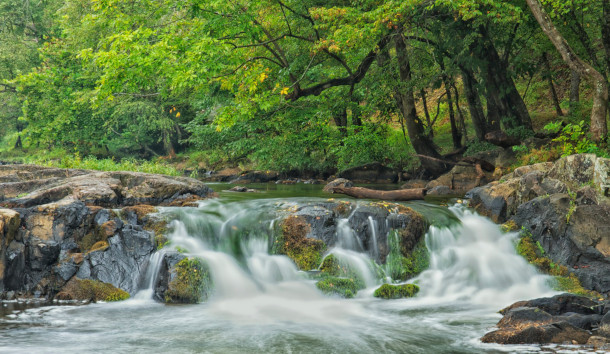
Eno River State Park is in Durham, North Carolina. (Photo: Jim Liestman, Flickr, CC BY-NC-ND 2.0)
[SFX]
O’NEILL: We leave you this week with the sound of the Eno River as it flows through Durham, North Carolina.
[SFX]
In the late 1960s, the city of Durham planned to dam the river and use it as a water source, but locals rallied together in opposition.
[SFX]
The river flows freely today thanks to the Eno River Association, North Carolina State Parks, and the City of Durham, all of which protect and maintain portions of the river and its surrounding watershed.
The Eno River gives life to great blue herons, Eastern box turtles, and yellow trout lilies, among many other species.
[SFX]
And it brings a sense of beauty and wonder to the people who visit.
Living on Earth intern Fern Alling recorded this audio in Eno River State Park in March 2023.
[SFX]
Related link:
Visit Eno River State Park
[MUSIC: Michael Hedges, “Rikki’s Shuffle” on Live On the Double Planet, by Michael Hedges, Windham Hill Records]
DOERING: Coming up on the next Living on Earth, we'll hear how humans pose a threat to cougars on the Olympic Peninsula, as well as the harrowing, yet inspiring, story of an orphaned cougar named Scalp and how she built a little family of her very own.
GROSS: There was a girl and a boy, just three weeks old. And this family carries special meaning for the team. And that's because their mother, Scalp, had actually surprised everybody by surviving after the state actually made her an orphan at just ten months old. It's very unusual for young cougars of a year old, even, to make it on their own, because they can stay with their moms up to eighteen months to learn how to take deer down and hunt on their own. And her mother had been killed for taking somebody's goats, a couple of goats, and left her an orphan. Yet she managed to make it. And then she seemed to have been one of the youngest cougar mothers that they ever documented.
DOERING: Cougar kittens and more, next week on Living on Earth.
[MUSIC: Michael Hedges, “Rikki’s Shuffle” on Live On the Double Planet, by Michael Hedges, Windham Hill Records]
DOERING: Living on Earth is produced by the World Media Foundation. Our crew includes Naomi Arenberg, Paloma Beltran, Josh Croom, Swayam Gagneja, Mattie Hibbs, Mark Kausch, Mark Seth Lender, Don Lyman, Sarah Mahaney, Sophia Pandelidis, Jake Rego, El Wilson, and Jolanda Omari.
O’NEILL: Tom Tiger engineered our show. Alison Lirish Dean composed our themes. You can hear us anytime at LoE.org, Apple Podcasts and Google Podcasts, and like us, please, on our Facebook page - Living on Earth. We tweet from @livingonearth. And find us on Instagram at livingonearthradio. And you can write to us at comments@loe.org. Steve Curwood is our Executive Producer. I’m Aynsley O’Neill
DOERING: And I’m Jenni Doering. Thanks for listening!
ANNOUNCER: Funding for Living on Earth comes from you, our listeners, and from the University of Massachusetts, Boston, in association with its School for the Environment, developing the next generation of environmental leaders. And from the Grantham Foundation for the protection of the environment, supporting strategic communications and collaboration in solving the world’s most pressing environmental problems.
ANNOUNCER 2: PRX.
Living on Earth wants to hear from you!
Living on Earth
62 Calef Highway, Suite 212
Lee, NH 03861
Telephone: 617-287-4121
E-mail: comments@loe.org
Newsletter [Click here]
Donate to Living on Earth!
Living on Earth is an independent media program and relies entirely on contributions from listeners and institutions supporting public service. Please donate now to preserve an independent environmental voice.
NewsletterLiving on Earth offers a weekly delivery of the show's rundown to your mailbox. Sign up for our newsletter today!
 Sailors For The Sea: Be the change you want to sea.
Sailors For The Sea: Be the change you want to sea.
 The Grantham Foundation for the Protection of the Environment: Committed to protecting and improving the health of the global environment.
The Grantham Foundation for the Protection of the Environment: Committed to protecting and improving the health of the global environment.
 Contribute to Living on Earth and receive, as our gift to you, an archival print of one of Mark Seth Lender's extraordinary wildlife photographs. Follow the link to see Mark's current collection of photographs.
Contribute to Living on Earth and receive, as our gift to you, an archival print of one of Mark Seth Lender's extraordinary wildlife photographs. Follow the link to see Mark's current collection of photographs.
 Buy a signed copy of Mark Seth Lender's book Smeagull the Seagull & support Living on Earth
Buy a signed copy of Mark Seth Lender's book Smeagull the Seagull & support Living on Earth

